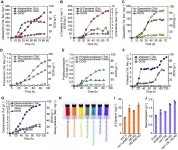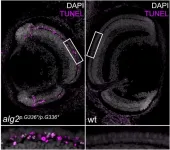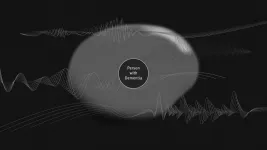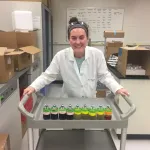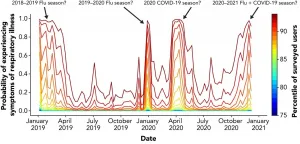A new approach will help save X-ray studies from failing results
A new approach will help save X-ray studies from failing results due to the peculiarities of single-crystal X-ray optics
2021-06-09
(Press-News.org) X-rays are widely used to study the structures of various objects. New sources of x-rays, like Free Electron Lasers and 4th generation synchrotrons are being built around the Globe. The best optics for the new sources is usually made of the single crystal materials, such as silicon, germanium or diamond. However, the ideal periodicity of crystals leads to some unwanted diffraction losses - X-ray glitches. This effect causes dips in the intensity of the radiation transmitted through the optical element, down to zero. Scientists from the Immanuel Kant Baltic Federal University with foreign colleagues have developed a method that allows not only to predict the appearance of glitches but even to eliminate their influence on experiments.
The structure of a substance determines its properties. Therefore, there is no need to dispute the importance of materials science. The most effective, non-destructive, and actively developing nowadays are X-ray methods based on the interaction of the corresponding radiation with a substance. Its new sources (generations 4+) generate X-ray beams with immensely high brightness and a degree of spatial coherence. For taking full advantage of such beams, new optics capable of fully forming, focusing, and transporting radiation without significant distortions and losses, are required. Not any material is suitable - the features of its atomic structure and the presence of any surface and volume inhomogeneities can significantly affect the outcome.
Single-crystal diamond has long been assumed as an ideal candidate for the material for manufacturing X-ray optics: it is mechanically and thermally stable, poorly absorbs radiation, has a small number of impurities, and a suitable crystal structure. This means it is an X-ray amorphous material, which microstructure prevents a beam from scattering. So the radiation is used by scientists without losses, and the optics based on it has increased resolution and sensitivity. However, working with a single crystal diamond possesses one issue - the effect of diffraction loss or X-ray glitches. So are the "dips" in the intensity of radiation passed through the optical element are called. It happens when the X-ray beam passes through the optical element, for some wavelengths the condition (called the Wolfe-Bragg condition) fulfills then a part of the transmitted radiation is diffracted in an undesirable direction. This condition could be met rather often, especially for "hard" radiation (with a small wavelength).
Glitches can be inconvenient to researchers in experiments in which a wavelength of the incident radiation changes during measurements. Thus, the jumping intensity for different wavelengths might occur. Even worse, at a constant wavelength, one can accidentally hit the glitch and carry out the entire experiment either at a lower or "floating" intensity. Respectively, this effect has to be taken into account in any research.
"The glitch effect has been known in spectroscopy for a long time and brings some discomfort to researchers. In some cases, they try to ignore it. Otherwise, it is easier to discard the damaged part of the obtained data. However, glitches can appear in any experiment: if with small changes in the radiation intensity, it is possible to compensate for the negative effects by normalizing the transmitted intensity to the incident one, with a strong drop in the intensity, the signal under study can simply "drown" in the noise", says Nataliya Klimova, Research Associate at the IKBFU International Science and Research Center "Coherent X-ray Optics for Megascience facilities".
Scientists from the IKBFU and their colleagues from the Center for Free-Electron Laser Science (CFEL) and from the European Synchrotron Radiation Facility (ESRF) have developed a method for accurate simulation and prediction of glitches, as well as getting rid of them. It can be applied to any single-crystal materials. The proposed approach does not require complex calculations, and therefore can be carried out right during the research. Before starting the experiment, it will be necessary to make only one measurement of the spectrum of radiation transmitted through the optical element. Based on the data obtained, using the developed program, it is possible to determine the exact orientation of the lens (or other optical elements) and then calculate where on the spectrum glitches may appear. Moreover, the proposed algorithm allows one to suppress specific glitches in the radiation spectrum. The authors confirmed their theoretical calculations in the course of experiments. The developed program is publicly available and applicable to any X-ray source.
"The results in this article not only continue the study of the previously discovered effect of diffraction losses in single-crystal X-ray optics but offer a reliable way to deal with them under experimental conditions. It will increase the efficiency of refractive single-crystal optics and let tune the work at the beamlines of the 4th generation synchrotron radiation sources", says Anatoly Snigirev, director of the IKBFU International Science and Research Center "Coherent X-ray Optics for Megascience facilities".
Scientists continue to work on this topic and are planning additional applications of the discovered effects at modern X-ray sources. Corresponding articles will be published soon.
"This article is just the beginning. Once again, we made sure that correct data processing is not only necessary but also rewarding. A correct physical model allowed us to fully explain the experimental data and also to come up with excellent applications for, at first glance, negative effects. Thus, shortly, we'll publish even more exciting articles on this topic!" says Oleksandr Yefanov, Seniour Researcher at the German Research Center for Free-Electron Laser Science, DESY, Hamburg.
INFORMATION:
[Attachments] See images for this press release:

ELSE PRESS RELEASES FROM THIS DATE:
2021-06-09
Language is one of our species' most important skills, as it has enabled us to occupy nearly every corner of the planet. Among other things, language allows indigenous societies to use the biodiversity that surrounds them as a "living pharmacy" and to describe the medicinal properties of plants. Linguists estimate that there are nearly 7,400 languages in the world today.
Most of these languages, however, are not recorded in writing, and many languages are not being passed on to the next generation. This has led linguists to estimate that 30 percent of all languages will disappear by the end of the 21st century. For indigenous cultures who mostly transmit knowledge orally, this ...
2021-06-09
A research group at KAIST has engineered bacterial strains capable of producing three carotenoids and four violacein derivatives, completing the seven colors in the rainbow spectrum. The research team integrated systems metabolic engineering and membrane engineering strategies for the production of seven natural rainbow colorants in engineered Escherichia coli strains. The strategies will be also useful for the efficient production of other industrially important natural products used in the food, pharmaceutical, and cosmetic industries.
Colorants are widely used in our lives and are directly related to human health when we eat food additives and wear cosmetics. However, most of these colorants are made from petroleum, causing unexpected side effects and health problems. Furthermore, ...
2021-06-09
Feelings of anxiety, pessimism and depression during the COVID-19 pandemic led middle-aged women in both Australia and the UK to stock up on alcohol, which was associated with drinking more, a new Flinders University-led study has found.
The research, led by Dr Emma Miller in Flinders University's College of Medicine and Public Health, also found women in the UK were more likely to drink at risky levels than their Australian counterparts during lockdown, and were more likely to have stockpiled alcohol.
Despite these differences, the research found the emotional responses to ...
2021-06-09
Tsukuba, Japan - Ceramic materials that are resistant to cracking are used in a variety of industries from aerospace engineering to dentistry. Toughening them to improve their efficiency and safety is therefore an important area of investigation. Researchers from the University of Tsukuba have used time-resolved X-ray diffraction to observe transformation toughening in zirconia ceramics during dynamic fracture. Their findings are published in Applied Physics Letters.
Current methods of observation allow the formation of cracks in materials to be observed in situ while loads are applied. These close-up analyses ...
2021-06-09
Human cells are kept healthy by the activity of millions of proteins. These proteins are modified in different ways, such as by adding sugar molecules to them, which can be crucial for them to function properly. Given this importance, defects in the sugar-adding process are often lethal at the very early stages of development. In rare cases, however, patients can develop sugar-adding deficiencies that result in a range of metabolic diseases, known collectively as 'congenital disorders of glycosylation' (CDG). These disorders are caused by defects in the enzymes involved in the sugar-adding process. For example, ALG2-CDG (or CDG-Ii) is a disorder caused by mutations in the ALG2 enzyme, ...
2021-06-09
MELVILLE, N.Y., June 9, 2021 -- Designing a soundscape to improve the quality of life for an individual is centered on putting their perception at the heart of the process. It becomes trickier for people who have diminished cognitive capacities.
During the 180th Meeting of the Acoustical Society of America, which will be held virtually June 8-10, Arezoo Talebzadeh, from Ghent University, will show how a personalized soundscape can help those with dementia by providing clues regarding time of day and place. The session, "Soundscape design for people with dementia; the correlation between psychoacoustic parameter and human perception," will take place Wednesday, June 9, ...
2021-06-09
UPTON, NY--How do you spot a subatomic neutrino in a "haystack" of particles streaming from space? That's the daunting prospect facing physicists studying neutrinos with detectors near Earth's surface. With little to no shielding in such non-subterranean locations, surface-based neutrino detectors, usually searching for neutrinos produced by particle accelerators, are bombarded by cosmic rays--relentless showers of subatomic and nuclear particles produced in Earth's atmosphere by interactions with particles streaming from more-distant cosmic locations. These abundant travelers, mostly muons, create a web of crisscrossing particle tracks that can easily obscure a ...
2021-06-09
Fruits, vegetables, red wine and chocolate are all rich in polyphenols, natural plant compounds that double as cancer-fighting antioxidants. We can access these foods' health benefits because the microbes in our guts happily feast on them, breaking them down into smaller chemical components.
Microbiome scientists at Colorado State University wanted to know if microbes can also break down those same polyphenols in systems outside the human body, including the microbial wild west of soils.
A research team led by Kelly Wrighton, associate professor in the College of Agricultural Sciences' Department of Soil and Crop Sciences, has uncovered new insights into the role of polyphenols in the soil microbiome, known as a black box for its complexity. They proffer an updated theory that soils ...
2021-06-09
Los Angeles (June 8, 2021) --
IBDs, including Crohn's disease and ulcerative colitis, are chronic conditions that occur when the intestinal immune system becomes overreactive, causing chronic diarrhea and other digestive symptoms. In a published survey at the beginning of COVID-19 vaccine distribution, 70% of IBD patients reported concern about side effects from the vaccines.
"What we've learned is that if you have IBD, the side effects you're likely to experience after a vaccine are no different than they would be for anyone else," said Gil Melmed, MD, corresponding author of the study and director of Inflammatory Bowel Disease Clinical Research at Cedars-Sinai. "If ...
2021-06-09
Real-world data from Sleep Number® smart bed sleepers shows a potential model for predicting and tracking COVID-19 infection using sleep and biometric measures.
Analysis of 18.2 million 360 smart bed sleep sessions finds heart rate variability differs with age, gender and day of the week.
MINNEAPOLIS, MN -- June 9, 2021 -- Today, END ...
LAST 30 PRESS RELEASES:
[Press-News.org] A new approach will help save X-ray studies from failing results
A new approach will help save X-ray studies from failing results due to the peculiarities of single-crystal X-ray optics


